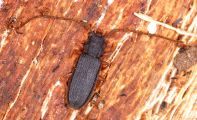
Русские, остановите эту войну! Спасите Свободную Украину!
Russians, stop this war! Save Free Ukraine!
Biodiversity Map
Taxa

Uleiota — subordinate taxa:
Taxon count: 1
-
Arthropodaphylum
Click to switch
to select orders
and filters > -
Hexapodasubphylum
Click to switch
to select orders
and filters > -
Insectaclass
Click to switch
to select orders
and filters > -
Coleopteraorder
Click to set
as the main taxon
and as a base
← of the left panel > -
Polyphagasuborder
Click to set
as the main taxon
and as a base
← of the left panel > -
Cucujiformiaseries
Click to set
as the main taxon
and as a base
← of the left panel > -
Cucujoideasuperfamily
Click to set
as the main taxon
and as a base
← of the left panel > -
Silvanidaefamily
Click to set
as the main taxon
and as a base
← of the left panel > -
Brontinaesubfamily
Click to set
as the main taxon
and as a base
← of the left panel > -
Brontinitribe
Click to set
as the main taxon
and as a base
← of the left panel > -
Uleiotagenus
Click to set
as the main taxon
and as a base
← of the left panel >
PL
YES
name status: valid name
BioMap ID: 1018276
taxon code: 3374
taxonomy checked: YES
Data on distribution in Poland

Statistics
- Records: 164
- Publications: 37
- Collections: 13
- Publication authors: 40
- Illustrations (iconography): 1
- Photos (specimen/observation): 6
Taxon description
Gatunek rozprzestrzeniony od Anglii, południowych prowincji Fennoskandii i Karelii aż do krajów śródziemnomorskich, notowany nadto z Kaukazu i Iranu. W Polsce występuje na terenach nizinnych i pagórkowatych na całym obszarze, nie notowany jednak jeszcze z niektórych krain. Występuje pod obluźnioną korą drzew liściastych, bardzo rzadko również iglastych, zwłaszcza sosen. Postacie dojrzałe są spotykane w ciągu całego roku. Larwy przypuszczalnie odżywiają się wyciekającymi sokami podkorowymi oraz ekstrementami owadów.
Illustrations
... browse
 Uleiota
Uleiotaplanatus
Photos
... browse
 Uleiota
Uleiotaplanatus
 Uleiota
Uleiotaplanatus
 Uleiota
Uleiotaplanatus
 Uleiota
Uleiotaplanatus
 Uleiota
Uleiotaplanatus
 Uleiota
Uleiotaplanatus
External data sources
- Ostatnie rekordy
-
1140671
 ⊡
⊡ Silvanidae: Uleiota planatus, PL, Pojezierze Pomorskie, Pojezierze Południowopomorskie, Bory Tucholskie, nadl. Osie, Wdecki P.K., kujawsko-pomorskie, Świecie, Osie, ad Osie, UTM CE24, 1998 (Gutowski et al. 2005a)
Silvanidae: Uleiota planatus, PL, Pojezierze Pomorskie, Pojezierze Południowopomorskie, Bory Tucholskie, nadl. Osie, Wdecki P.K., kujawsko-pomorskie, Świecie, Osie, ad Osie, UTM CE24, 1998 (Gutowski et al. 2005a) -
1115353
 ⊡
⊡ Silvanidae: Uleiota planatus, PL, Wyżyna Krakowsko-Wieluńska, Brama Krakowska, Obniżenie Cholerzyńskie, małopolskie, Kraków m., Kraków, Bronowice, UTM DA14, 2019, leg. M. Syratt
Silvanidae: Uleiota planatus, PL, Wyżyna Krakowsko-Wieluńska, Brama Krakowska, Obniżenie Cholerzyńskie, małopolskie, Kraków m., Kraków, Bronowice, UTM DA14, 2019, leg. M. Syratt -
1115284
 ⊡
⊡ Silvanidae: Uleiota planatus, PL, Wyżyna Krakowsko-Wieluńska, Brama Krakowska, Obniżenie Cholerzyńskie, małopolskie, Kraków m., Kraków, Bronowice, UTM DA14, 2019, leg. M. Syratt
Silvanidae: Uleiota planatus, PL, Wyżyna Krakowsko-Wieluńska, Brama Krakowska, Obniżenie Cholerzyńskie, małopolskie, Kraków m., Kraków, Bronowice, UTM DA14, 2019, leg. M. Syratt -
1115181
 ⊡
⊡ Silvanidae: Uleiota planatus, PL, Wyżyna Lubelska, Wyżyna Lubelska, Małopolski Przełom Wisły, lubelskie, Puławy, Puławy m., Puławy, UTM EB69, 2019, leg. M. Miłkowski
Silvanidae: Uleiota planatus, PL, Wyżyna Lubelska, Wyżyna Lubelska, Małopolski Przełom Wisły, lubelskie, Puławy, Puławy m., Puławy, UTM EB69, 2019, leg. M. Miłkowski -
1111048
 ⊡
⊡ Silvanidae: Uleiota planatus, PL, Wyżyna Krakowsko-Wieluńska, Kraków, UTM DA24, 1991, leg. P. Babula
Silvanidae: Uleiota planatus, PL, Wyżyna Krakowsko-Wieluńska, Kraków, UTM DA24, 1991, leg. P. Babula -
1111047
 ⊡
⊡ Silvanidae: Uleiota planatus, PL, Wyżyna Lubelska, Lublin / Zemborzyce, UTM FB06, 1989, leg. J. Mazepa
Silvanidae: Uleiota planatus, PL, Wyżyna Lubelska, Lublin / Zemborzyce, UTM FB06, 1989, leg. J. Mazepa -
1092944
 ×
× Silvanidae: Uleiota planatus, PL, Nizina Wielkopolsko-Kujawska, Puszcza Notecka, Elżbiecin, 1989, leg. J. Siekierski, coll. Muz. Górnośląskie, Bytom
Silvanidae: Uleiota planatus, PL, Nizina Wielkopolsko-Kujawska, Puszcza Notecka, Elżbiecin, 1989, leg. J. Siekierski, coll. Muz. Górnośląskie, Bytom -
1092943
 ⊡
⊡ Silvanidae: Uleiota planatus, PL, Nizina Mazowiecka, Wilga, UTM EC24, 1993, leg. J. Siekierski
Silvanidae: Uleiota planatus, PL, Nizina Mazowiecka, Wilga, UTM EC24, 1993, leg. J. Siekierski -
1074475
 ⊡
⊡ Silvanidae: Uleiota planatus, IR, Golestān Forest, Golestān, ad Minudasht, 2015, leg. A. Lasoń
Silvanidae: Uleiota planatus, IR, Golestān Forest, Golestān, ad Minudasht, 2015, leg. A. Lasoń -
1071549
 ⊡
⊡ Silvanidae: Uleiota planatus, AZ, Talysh Mountains, Lerik rayonu, ad Peştətük, 2014, leg. A. Lasoń
Silvanidae: Uleiota planatus, AZ, Talysh Mountains, Lerik rayonu, ad Peştətük, 2014, leg. A. Lasoń - ... more
- Powiązane publikacje
-
Plewa R., Jaworski T., Hilszczański J., Horák J. 2017a. Investigating the biodiversity of the forest strata: The importance of vertical stratification to the activity and development of saproxylic beetles in managed temperate deciduous forests. For. Ecol. Manage., 402:186-193.
 Show records
Show records -
Plewa R., Jaworski T., Hilszczański J. 2014b. Martwe drewno a jakościowa i ilościowa struktura chrząszczy (Coleoptera) saproksylicznych w drzewostanach dębowych. Studia i Materiały CEPL w Rogowie, 41(4):279-299.
 Show records
Show records -
Ruta R., Żuk K., Lasoń A. 2008. Nowe stanowiska Carpophilus sexpustulatus (Fabricius, 1792) (Coleoptera: Nitidulidae) w Polsce. Wiad. Entomol., 27(2):116-117 [476].
 full text
full text Show records
Show records -
Byk A. 2007. Waloryzacja lasów Gór Świętokrzyskich na podstawie struktury zgrupowań chrząszczy saproksylicznych. [In:] Borowski J., Mazur S. (Eds.) Waloryzacja ekosystemów leśnych Gór Świętokrzyskich metodą zooindykacyjną. Wydawnictwo SGGW, Warszawa. pp. 57-118.
 Show records
Show records -
Gutowski J.M., Kubisz D., Buchholz L. 2005a. Chrząszcze (Coleoptera) drzewostanów sosnowych w Borach Tucholskich. [In:] Gwoździński K. (Ed.) Bory Tucholskie III. Zasoby i ich ochrona. Wydawnictwo Uniwersytetu Łódzkiego, Łódź, 276 pp.. pp. 113-135.
 Show records
Show records - ... more






